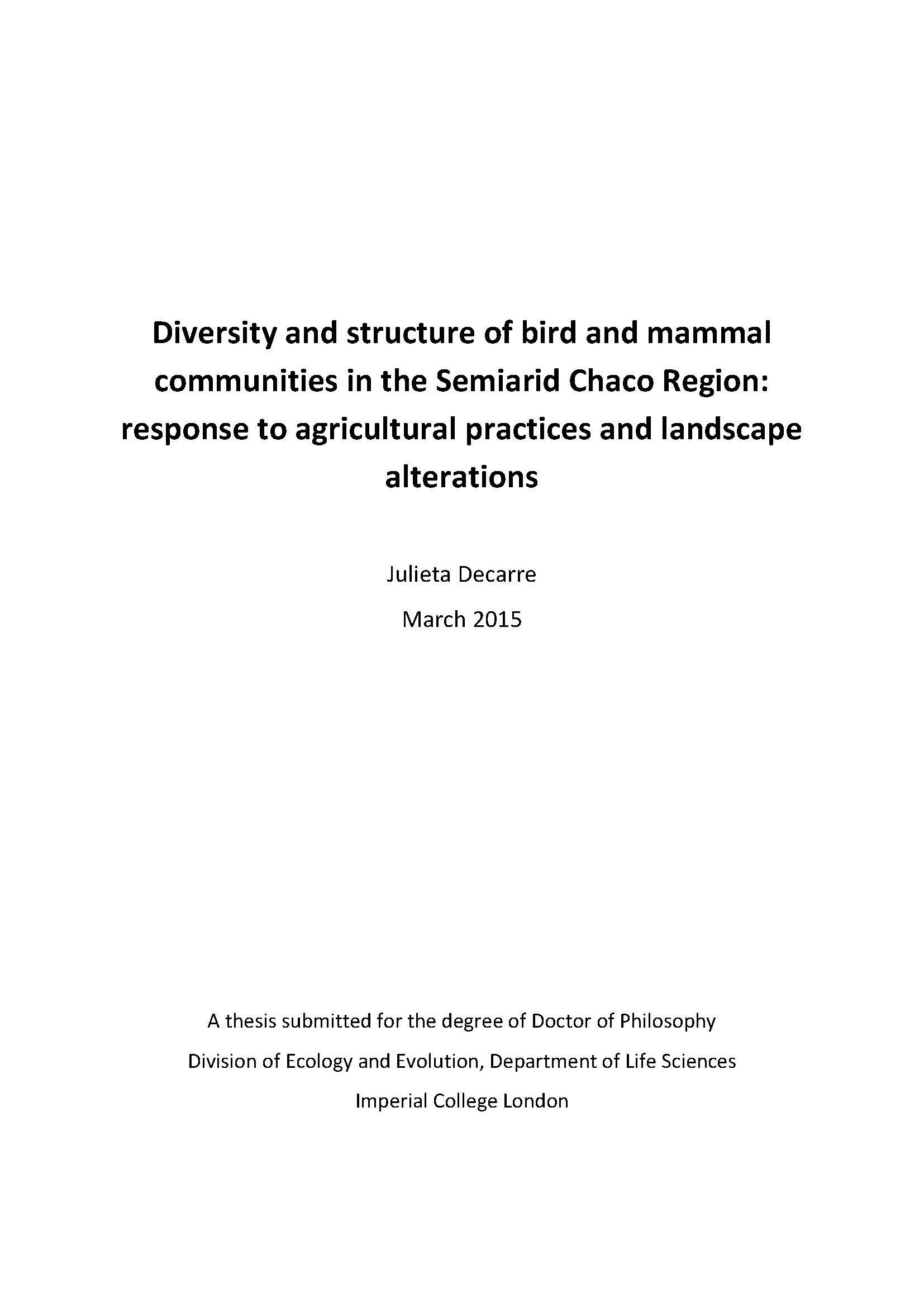Ver ítem
- xmlui.general.dspace_homeCentros e Institutos de InvestigaciónCIRN. Centro de Investigaciones de Recursos NaturalesInstituto de Recursos BiológicosTesisxmlui.ArtifactBrowser.ItemViewer.trail
- Inicio
- Centros e Institutos de Investigación
- CIRN. Centro de Investigaciones de Recursos Naturales
- Instituto de Recursos Biológicos
- Tesis
- Ver ítem
Diversity and structure of bird and mammal communities in the Semiarid Chaco Region: response to agricultural practices and landscape alterations
Resumen
The conversion of land from natural environments to human-managed areas has been particularly pronounced in the semiarid Chaco Region. In this context, it is critical to understand the impacts that these major changes have on species diversity. The specific aims of this thesis were to understand: i) how the different human-modified environments influenced the distribution of the bird assemblages in the current agricultural matrix; ii) which local and
[ver mas...]
The conversion of land from natural environments to human-managed areas has been particularly pronounced in the semiarid Chaco Region. In this context, it is critical to understand the impacts that these major changes have on species diversity. The specific aims of this thesis were to understand: i) how the different human-modified environments influenced the distribution of the bird assemblages in the current agricultural matrix; ii) which local and landscape scale characteristics best explained species richness and relative abundance of mammals; and iii) what is the relationship between biodiversity and profit for both taxa, and given this relationship, to what extent can conservation and production objectives be simultaneously achieved. Bird and mammal community data was gathered in seven different habitats of an agricultural matrix and inside a National Park. Bird species richness and abundance were extremely low in highly modified environments (agriculture plots), but increased significantly in intermediate, or low modified habitats (silvopasture plots, forest outside and inside the National Park, respectively). Richness and capture frequency of mammals increased gradually across the gradient of habitat modification, from low numbers in agricultural habitats to a maximum in National Park forests. Changes in species composition with production intensification differed between birds and mammals. The bird communities were similar for low- and intermediate-intensity farming, with constant number of species, abundance and community integrity. However, further intensification led to an abrupt decline, defining a clear threshold. Mammal species richness was maintained in low-yield farming, relative abundance declined with increasing production, favoured by a wildlife-friendly farming approach. In contrast to birds, mammal community integrity decreased exponentially with increased levels of intensification, showing that only protected or well-preserved forests can support some habitat-restricted species. The results suggest that a combined strategy is the best option to achieve conservation and production targets that include both taxa.
[Cerrar]

Autor
Director de Tesis
Carbone, Chris (supervisor);
Banks-Leite, Cristina (supervisora);
Descripción
Tesis para obtener el grado de Doctor of Philosophy (PhD) en Life Sciences, del Imperial College London, en 2015
Fecha
2015-03
Editorial
Imperial College London, Gran Bretaña
Formato
pdf
Tipo de documento
tesis doctoral
Palabras Claves
Derechos de acceso
Abierto
 Excepto donde se diga explicitamente, este item se publica bajo la siguiente descripción: Creative Commons Attribution-NonCommercial-ShareAlike 2.5 Unported (CC BY-NC-SA 2.5)
Excepto donde se diga explicitamente, este item se publica bajo la siguiente descripción: Creative Commons Attribution-NonCommercial-ShareAlike 2.5 Unported (CC BY-NC-SA 2.5)


